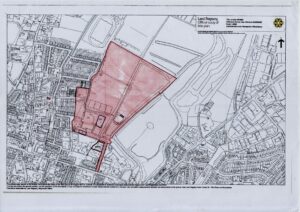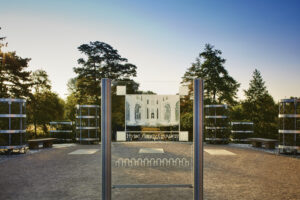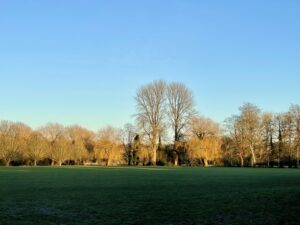The park is well used and loved by many. For instance, there are dog walkers and fitness groups throughout the day, school children before and after school, families throughout the week, and sports teams and clubs in the evenings and at weekends. It is a welcoming green space for visitors to the city, and it hosts many, varied, community events throughout the year. The park is also used by youth groups, schools and other organisations. The vast open green space is a wonderful environment for everyone to relax in and to enjoy – River Park is certainly a place to play and it is freely open to all.
History/Context
You may ask why River Park came into being in the first place. It was a legacy from the Alfred the Great 1000-year celebrations in 1901, which included the unveiling in September 1901 of the great King’s statue, created by Sir Hamo Thorneycroft, in the Broadway.
The main man behind those celebrations, Mayor Alfred Bowker, felt strongly there should be a legacy to commemorate Alfred, “the Founder of the Kingdom and Nation” (as was written on the plaque below the statue), and the Winchester residents agreed. Together, they decided that the legacy should take the form of a purchase by the city and its residents of the Hyde Abbey Gateway and the River Park area, including what is now Hyde Abbey Garden. These monuments and pieces of land all hold historic connections to King Alfred in that, in 1110, monks took Alfred’s remains, together with those of his wife Alswitha and their son Edward the Elder (and some well-loved saints), through the city from the Old Minster to be reburied in the newly commissioned Great Church of Hyde Abbey.
There was a fund-raising exercise amongst residents and, with a loan arranged from the Local Government Board, to be paid back through an additional levy on local rates, the purchase was agreed in 1902 with the Barrow Simmonds family. This was an important Winchester family, much involved with good deeds in Winchester, who had bought the land (the former Hyde Abbey Barton Farm) from the family of Jane Austen’s brother Edward Knight, whose name was changed from Austen as part of an inheritance.
The Recreation Ground, as it became known, took some time to become established, as the land required to be raised, because of the flood risk, and levelled for the playing fields. This was not without some friction between the city and its ratepayers because of the spiralling costs. But from 1908 the football pitches were available, boats for hire in the streams from 1909 and the construction of the bowling green was started in 1910.
River Park is a very historic site and it was an integral part of Hyde Abbey. The Abbey was a large Benedictine monastery which owned meadowland to the east, now the Recreation Ground. It was dissolved by King Henry VIII’s henchman, Sir Thomas Wriothsley, in 1538. The chancel of the Great Church is now marked by Hyde Abbey Garden, created in 2003 as Winchester’s Jubilee project and designed by Kim Wilkie, internationally renowned garden designer and Hampshire resident. The garden echoes the archaeological remains of the Abbey Church which lie beneath it.


